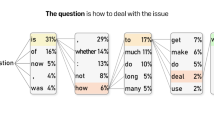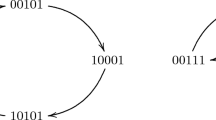Abstract
We show that every languageL in the class ACC can be recognized by depth-two deterministic circuits with a symmetric-function gate at the root and\(2^{\log ^{O(1)} n} \) AND gates of fan-in logO(1) n at the leaves, or equivalently, there exist polynomialsp n (x 1 ,..., x n ) overZ of degree logO(1) n and with coefficients of magnitude\(2^{\log ^{O(1)} n} \) and functionsh n :Z→{0,1} such that for eachn and eachx∈{0,1}n,XL (x) =h n (p n (x 1 ,...,x n )). This improves an earlier result of Yao (1985). We also analyze and improve modulus-amplifying polynomials constructed by Toda (1991) and Yao (1985).
Similar content being viewed by others
References
M. Ajtai, 364-1 formulae on finite structures.Annals of Pure and Applied Logic 24 (1983), 1–48.
E. Allender, A note on the power of threshold circuits. InProc. 30th Ann. IEEE Symp. Found. Comput. Sci., 1989, 580–584.
E. Allender and U. Hertrampf, Depth reduction for circuits of unbounded fanin.Inform. and Comput. 108 (1994). To appear.
N. Atiyah and I. MacDonald,Introduction to Commutative Algebra. Addison-Wesley, 1969.
D. A. Barrington, Bounded-width polynomial-size branching programs recognize exactly those languages inNC 1.J. Comput. System Sci. 38(1), (1989), 150–164.
D. A. M. Barrington, Quasipolynomial size circuit classes. InProc. 7th Ann. IEEE Conf. Structure in Complexity Theory, 1992, 86–93.
D. A. M. Barrington andD. Thérien, Finite monoids and the fine structure ofNC 1.J. Assoc. Comput. Mach. 35(4) (1988), 941–952.
R. Beigel, The polynomial method in circuit complexity. InProc. 8th Ann. IEEE Conf. Structure in Complexity Theory, 1993, 82–95.
R. Beigel andJ. Gill, Counting classes: Thresholds, parity, mods, and fewness.Theoret. Comput. Sci. 103(1) (1992), 3–23.
R. Beigel and J. Tarui, On ACC. InProc. 32nd Ann. IEEE Symp. Found. Comput. Sci., 1991, 783–792.
R. Beigel, N. Reingold, and D. Spielman, The perception strikes back. InProc. 6th Ann. IEEE Conf. Structure in Complexity Theory, 1991, 286–291.
R. Beigel, N. Reingold, and D. Spielman, PP is closed under intersection.J. Comput. System Sci. 48 (1994). To appear.
R. Boppana andM. Sipser, The complexity of finite functions. InHandbook of Theoretical Computer Science, Volume A: Algorithms and Complexity, ed.J. van Leeuwen, MIT Press and Elsevier, The Netherlands, 1990, 757–804.
A. K. Chandra, L. Stockmeyer, andU. Vishkin, Constant depth reducibility.SIAM J. Comput. 13(2) (1984), 423–438.
F. Green, J. Köbler, and J. Torán, The power of the middle bit. InProc. 7th Ann. IEEE Conf. Structure in Complexity Theory, 1992, 111–117. An extended version has been drafted by Green, Köbler, Regan, Schwentick, and Torán.
M. Furst, J. B. Saxe, andM. Sipser, Parity, circuits, and the polynomial-time hierarchy.Math. Systems Theory 17(1) (1984), 13–27.
J. T. Håstad,Computational Limitations for Small-Depth Circuits. ACM Doctoral Dissertation Award. MIT Press, Cambridge, MA, 1986.
D. Johnson, A catalog of complexity classes. InHandbook of Theoretical Computer Science, Volume A: Algorithms and Complexity, ed.J. van Leeuwen, MIT Press and Elsevier, 1990, 69–161.
R. Kannan, H. Venkateswaran, V. Vinay, and A. C. Yao, A circuit-based proof of Toda's theorem.Inform. and Comput. (1993). To appear.
P. McKenzie and D. Thérien, Automata theory meets circuit complexity. InProc. of the 16th ICALP, Lecture Notes in Computer Science 372, Springer-Verlag, 1989, 589–602.
A. A. Razborov, Lower bounds for the size of circuits of bounded depth with basis {Λ, ⊕}.Math. notes of the Academy of Science of the USSR 41 (4) (1987), 333–338.
M. Sipser, The history and status of the P versus NP question. InProc. Twenty-fourth Ann. ACM Symp. Theor. Comput., 1992, 603–618.
R. Smolensky, Algebraic methods in the theory of lower bounds for Boolean circuit complexity. InProc. Nineteenth Ann. ACM Symp. Theor. Comput., 1987, 77–82.
J. Tarui, Probabilistic polynomials, AC0 functions, and the polynomial-time hierarchy.Theoret. Comput. Sci. 113 (1993), 167–183.
S. Toda, PP is as hard as the polynomial-time hierarchySIAM J. Comput. 20(5) (1991), 865–877.
S. Toda andM. Ogiwara, Counting classes are at least as hard as the polynomial-time hierarchy.SIAM J. Comput. 21(2) (1992), 316–328.
A. C. Yao, Separating the polynomial-time hierarchy by oracles. InProc. 26th Ann. IEEE Symp. Found. Comput. Sci., 1985, 1–10.




